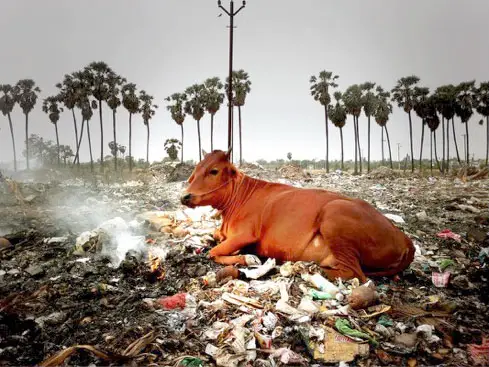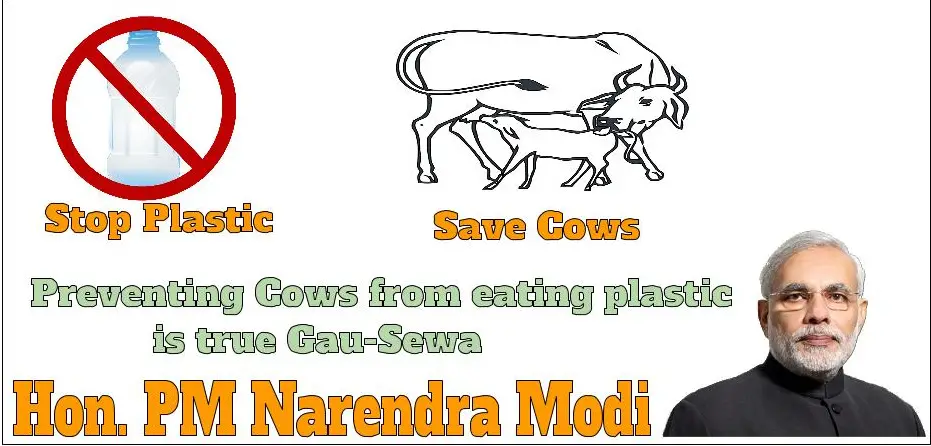We everyone knows how hazardous plastic is for the environment. Whenever we throws something like paper, food etc in the environment, there are some bacteria which grows on it, and covert this food, papers into something which mixes into the environment, some turning into useful for growing of trees, we call those items as biodegradable items. Biodegradable items are capable of being decomposed by bacteria or other living organisms and thereby avoiding pollution.
Whereas Plastic is a “Non-Biodegradable” item. Non-biodegradable waste is a type of waste that can not be broken down into its base compounds by micro-organisms, air, moisture or soil in a reasonable amount of time. Non-biodegradable waste is an environmental concern, as it threatens to overwhelm landfills and create disposal problems.

In past VSPCA (Visakha Society for Protection and Care of Animals), through their “Plastic Cow Project” has done extensive reasearch on the impacts of plastic on the street cows, and how they die a painful death due to having plastic in their stomach. VSPCA also tried to rescue those cows and do the operations on them to get the plastic removed. You can find mode details about the “Plastic Cow Project” as VSPCA website.
In 2013 , after petition from some Animal welfare organisation, Honerable Supreme court of India has said that “Plastic waste a ticking time bomb in India” and had directed the State Governments to issue appropriate directions prohibiting the use, sale and disposal of plastic bags in all municipalities and municipal corporations within their territory.

Last year ( 2015 ) Union Environment Minister Parkash Javadekar had said that every dead cow contains not less than 30 kgs of plastic. While talking in a town-hall meeting recently, Honorable Prime Minister Shri. Narendra Modi said that preventing cows from eating the plastic is the only way to save cows because more cows dies due to plastic than any other reason.
Now, as PM Modi has again highlighted the use of plastic and its harmful effects on environment and health and living of cows,Green Ecosystem vows to do all & everything we can do to suport PM’s statement and avoid use of plastic to save the environment & cows. We look forward for similar help from our readers and well wishers.
Reference :
http://southasia.oneworld.net – Plastic waste a ticking time bomb in India: Supreme Court
http://supremecourtofindia.nic.in/outtoday/wc15412p-2014_11_18.pdf
ndtv.com – 30 Kg Plastic Can Be Found in Every Dead Cow in India, Says Union Environment Minister


The dairy and cattle owners are
responsible for the plights of cows after milking
them in the morning. They allow the cows and
virtually push them out of shelters to find food
available in dumps of debris lying around the city.
The Indian Cow Oct-Dec, 2005
HARMFUL EFFECT OF PLASTIC IN ANIMALS
Bhupendra Singh, III/ 1, Ramganga Colony, Dhampur, Distt. Bijnor (UP)
Harmful Effects
The coming known examples of
hazardousness produced by plastics define that
only some of plastics are responsible for that –
Mainly polyethylene and Polyvinyle chloride
because both of these two are using for food
grade applications at very large scale.
Epidemiology
Though, there is no such systematic
study on polythene and plastic induced
pathological lesions in animals. However, there
are scattered reports in literature and that too in
popular media. An attempt is made to collect
information from various sources and present in
a consolidated form.
1. Five cows were choked to death in Jaipur due
to blockage of their digestive tract following
consumption of polythene bags.
2. Two cows were operated and 48 kg of
polythene and 287 foreign bodies were recovered
from rumen/ reticulum of the cows by Veterinary
Surgeons in Jammu.
3. On an average about 25 cases were recorded
each year in polyclinic of CCS HAU, Hisar, which
were operated to remove the polythene from
stomach of cows. It is believed that there are
much largers numbers of stray animals which
after conserving polythene simply end up in death.
4. As per the Greek publication plastic bags kill
10,000 Mediterranean fish each day.
5. It has been recorded that 95% of urban stray
cattle in India suffering from various ailments due
to hazardous material inside their abdomen, out
of them 90% are plastic bags.
6. Plastic bags are major cause of unsightly lit-
ter and also harm wildlife like deer etc. In a
report, polybezoars containing polythenes and
plant materials along with salt deposits were
found in stomach of a barking deer which
comprises into 3 pieces each measuring 4-5 cm
in diameter and hard to touch. It was found
responsible for blocking of rumeno-reticulum
opening leading to death of barking deer.
7. Plastic bags that end up at sea are easily
swallowed by marine life that mistake them for
food. An estimated 1,00,000 whales, seals, turtles
and other marine life die every year after
swallowing plastic bags.
8. A seriously ill cow was operated in Bhuj by a
Veterinary Surgeon and about 4000 plastic bags
were found in stomach with other non-digestible
waste.
9. In Delhi zoo, a Swamp deer and a Sangai deer
died due to plastic bags.
10.SPCA Veterinarian operated more than 15
cows and found about 10 kg plastic waste in
stomach of each cow.
Pathogenesis
The dairy and cattle owners are
responsible for the plights of cows after milking
them in the morning. They allow the cows and
virtually push them out of shelters to find food
available in dumps of debris lying around the city.
The Indian Cow Oct-Dec, 2005
Stray cows are generally seen on the roadsides
eating away the plastic bags and their contents
in search of food items.
The ingested polythene hinders the
process of fermentation and mixing of contents
leading to indigestion. They also obstruct the
orifice between reticulum and omasum. If not
removed though surgery, polythenes may become
fatal. The plastic bags cannot be digested or
passed as such through faeces by an animal.
They stay in the gut causing pain and death.
When dead animal decay, the bags are freed and
often eaten again by other animals and this cycle
may continue for many years to come. Marine
animals often mistake them for jellyfish and eat
them. The birds are many times entangled in
plastic bags who cannot fly then and die of
starvation.
The toxic contents of plastic may also enter
in man through milk produced by such cows. The
foreign bodies like hard metal needles, wires,
nails, etc. are also disposed alongwith other
house waste in polythene bags, which after
consuming by cows may settle in reticulum
giving rise to a condition “tranmatic reticulo
pericarditis (TRP)”. One can see many stray
cows found on roadsides with TRP where in their
foreleg portion is found swollen.
Pathology
Various pathological conditions are
encountered due to plastic and polythene in
animals.
1. Indigestion: The polythenes and other
plastic material do not degrade in rumen/
reticulum and remain as such causing hindrance
in orifice. When it is mixed with feed, the
ingredients are also trapped in between
polythenes which becomes tight due to ruminal
movements. This whole process also affects the
rumen microflora leading to indigestion of feed.
2. Impaction: Rumen becomes impacted due
to presence of large quantities of polythene bags/
plastics in rumen accumulated over a period of
time. This leads to rumenatony and decrease in
rumen motility.
3. Tympany: When polythenes present in rumen
and reticulum, they partially or completely occlude
the orifice of reticulum and omasum leading to
accumulation of gases in rumen. The situation
becomes worsen if such animal is fed with
legumes or other gas forming feed/ concentrates.
Accumulation of gases in rumen give rise to bloat
or tympany which becomes fatal, if the gases are
not properly removed. Sometimes the poly bags
present in rumen may also occlude oesophageal
orifice leading to hindrance in eructation. This
gives rise to dyspnoea and death.
4. Polybezoars: The formation of stones in
digestive tract and around polythenes is known
as polybezoars. In this the principal constituent
is polythene and plant material, around which
salts are deposited that gives rise to the
formation of hard stone like mass in stomach.
Such hard mass not only causes hindrance in
food passage but also leads to pain and
inflammation of rumen.
5. Traumatic reticulo pericarditis: Many times
nails, wires or other sharp hard objects are also
disposed in poly bags as waste and dropped in
waste pits. From where there may eaten up by
cows along with food/feed items and get trapped
in reticulum causing damage. With the passage
of time and ruminal movements sharp objects
penetrate wall of reticulum and diaphragm to
invade heart leading to traumatic pericarditis. One
may find many animals on streets with swollen
brisket region and pain. On postmortem
examination, bread and butter appearance of
heart has been recorded with presence of
needles/ sharp objects penetrating heart/
diaphragm through reticulum along with the
presence of large quantities of polythenes in
rumen and/or reticulum. Perforation of reticulum
and diaphragm by foreign body and presence of
adhesions are also observed.
6. Immunosuppression: It has been observed
that cows with polythenes in their stomach also
suffer from immunosuppression that leads to
increased sensitivity to various infections
particularly of haemorrhagic septicemia
(Pasteurellosis). During investigation of an
outbreak at Rishikesh, cows were suffering from
HS during rainy season. When postmortem
examination was conducted on dead cows, the
rumen was found completely filled with polythenes
with characteristic lesions of HS in lungs, brisket
and throat region. Polythenes and plastic contain
several chemicals like polyvinyl chloride,
cadmium, lead, acrylamide, polyethene, etc.,
which are known immunosuppressants.
Besides, due to lack of proper nutrition,
animal becomes weak and immunodeficient.
Such animals are also prone to development of
cancer. The presence of toxic chemicals may also
damage epithelial lining that leads to urolithiasis
particularly in kidneys.
Since there is no systematic
experimental study on the effect of polythenes
on livestock and/or human health, it is suggested
to undertake such studies with respect to clinical
pathology, histopathology and immunopathology
in cattle fed with different doses, colour and types
of polythenes.
Reasons for harmfulness by plastics polymeric
materials.
As the name plastics comes, the picture
or polyethylene comes in mind suddenly and click
the various forms of polyethylene because
polyethylene is famous as plastic. Generally
every one think that polyethylene is plastics and
plastic is polyethylene. while the actual picture is
too much differ with this thought. A man when
think about plastics it is 99% possible that he will
be in the contact of any form of plastics at that
time too. As it stands today it is impossible not
only during production but also in everyday life to
prevent the population from coming into contact
with plastics. In any case, approximately 70 – 80
% of food is packaged in various polymeric
materials.
Plastic industry contributes nearly 1/10 of
toxic releases in the environment. Significant
releases of toxic chemicals included:
Tri cloro ethane, Acetone, Methylene
chloride, Methyl ethyl ketone, Styrene, Toluene,
Benzene, 1,1,1,Trichloroethane. Other major
emissions form plastics production process
include sulphur oxides, Nitrous oxides, Methanol,
Ethylene oxide and volatile organic compounds.
Less visible but very serious is the pollution
generated by producing plastic resin. As
ethylene polymerized, the reactive mixture is
scrubbed with dilute aqueous caustic solutions
that became high volume pollutants.
Unfortunately PM appear to be a potential